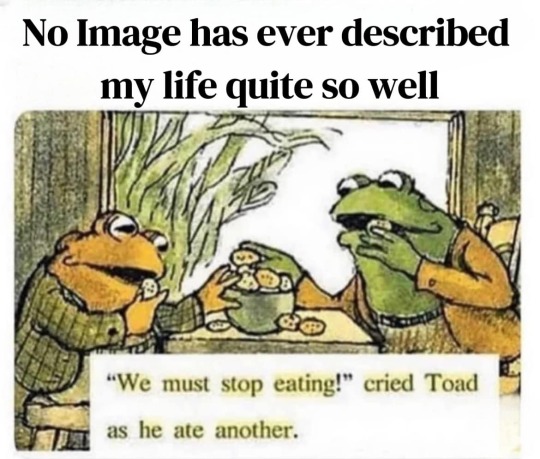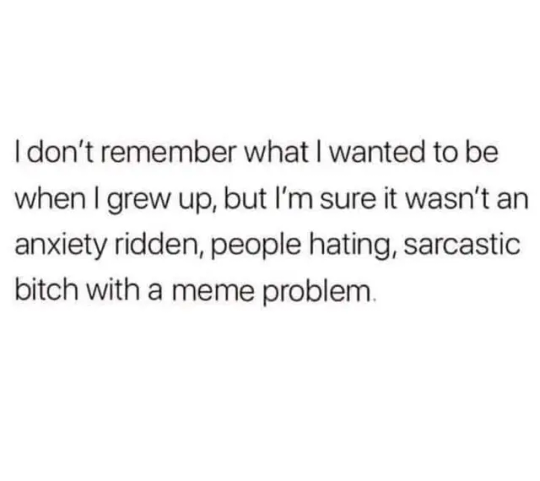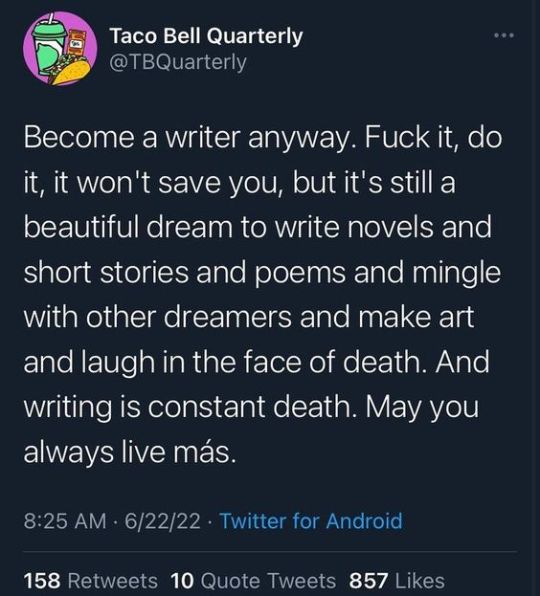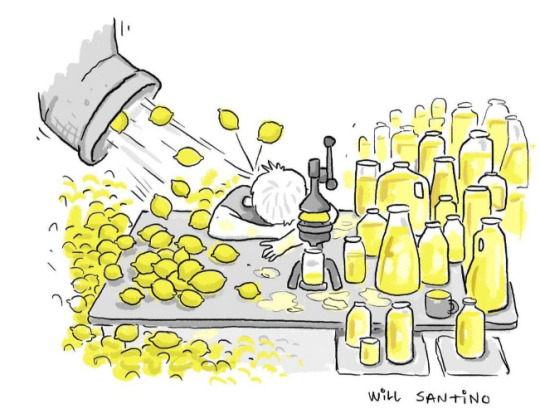Don't wanna be here? Send us removal request.
Text
“Nothing better than memories, and there is nothing worse than them.”
— Anton Chekhov
517 notes
·
View notes
Text
搭高鐵南返,行經你居住的縣城,霧靄盤桓如那夜我們說的話,攏著我一路南下。穿過丘陵地後霧散天晴,日光洶湧像眼淚,心仍在迷霧裡。
此情此景似曾相似,晃眼也十一年過去了。我該感到幸運,傷心時總能回到明媚的南方曬太陽,而你總得在那淒風苦雨的地方繼續過日子,若你當時能讓我明白你的苦楚,日後的心碎是否會少一點。
誤會你十年,這才知道過去的淚總歸是白流了,而從今往後才該痛哭。雙倍的淚,有我的痛悔,還有對你這些年來委屈隱忍的心疼。
教甄上岸那年,我意氣風發,以為此生除了家人安康再無所求,直至今日。知求之不得,卻又難免反覆揣想,竟不知感激地嘆息手上有太多時間,日日夜夜煎熬我的念想。白晝憶往期來,欲念叢生。夜裡心如火宅,焦灼難耐。
想要你好,又想要你記得;應該放下,又執著妄想。原諒我的軟弱與自私好嗎?我知道你會原諒我,就像你還是原諒我當初背你而去一樣。你嘴壞,但總是心軟,雖然我如今知道的已太遲。
曾經為你作的詩,為你寫的雜記,當年總怕自作多情,不敢表明,現在卻是不忍再告訴你。
千言萬語,憾恨難平。
0 notes
Text
Do Your Research
This phrase is regularly thrown around writeblr and for good reason. It's important to research what you are writing about to know what to include, what can be fudged, and how to depict whatever you're writing. I see "do your research" most thrown around by well-meaning and highly traditionally educated writers. It's solid advice, after all!
But how do you research?
For those writers who don't already have the research skills necessary to write something comfortably already downloaded into your brain, I put this guide together for you.
Where do I even start?
It's a daunting task, research. But the best place to start is with the most basic, stupidest question you can think of. I'm going to talk about something that I already know a lot about: fighting.
When researching fight scenes, a great way to start is to look up what different weapons are. There are tons out there! So ask the stupid questions. What is a sword? What is a gun? How heavy are they?
Google and Wikipedia can help you a lot with these basic-level questions. They aren't great sources for academic articles, but remember, this is fiction. It doesn't need to be perfect, and it doesn't need to be 100% accurate if you don't want it to be. But knowing what is true to life will help you write well. Just like knowing the rules of writing will help you break them.
You may find in your basic research sweep that you have a lot more specific questions. Write them all down. It doesn't matter if they seem obvious. Write them down because they will be useful later.
How To Use Wikipedia Correctly
Wikipedia is a testament to cooperative human knowledge. It's also easy to edit by anonymous users, which means there is a lot of room for inaccuracies and misleading information. Wikipedia is usually pretty good about flagging when a source is needed or when misleading language is obvious, but Wikipedia itself isn't always the most accurate or in-depth source.
Wikipedia is, however, an excellent collection of sources. When I'm researching a subject that I know nothing about, say Norse mythology, a good starting point is the Wikipedia page for Odin. You'll get a little background on Odin's name and Germanic roots, a little backstory on some of the stories, where they appear, and how they are told.
When you read one of the sentences, and it sparks a new question, write the question down, and then click on the superscript number. This will take you directly to the linked source for the stated fact. Click through to that source. Now you have the source where the claim was made. This source may not be a primary source, but a secondary source can still lead you to new discoveries and details that will help you.
By "source-hopping," you can find your way across the internet to different pieces of information more reliably. This information may repeat itself, but you will also find new sources and new avenues of information that can be just as useful.
You mean I don't need a library?
Use your library. Libraries in many parts of the US are free to join, and they have a wealth of information that can be easily downloaded online or accessed via hardcopy books.
You don't, however, need to read every source in the library for any given topic, and you certainly don't need to read the whole book. Academic books are different from fiction. Often their chapters are divided by topic and concept and not by chronological events like a history textbook.
For example, one of my favorite academic books about legislative policy and how policy is passed in the US, by John Kingdon, discusses multiple concepts. These concepts build off one another, but ultimately if you want to know about one specific concept, you can skip to that chapter. This is common in sociological academic books as well.
Going off of my Norse Mythology example in the last section, a book detailing the Norse deities and the stories connected to them will include chapters on each member of the major pantheon. But if I only care about Odin, I can focus on just the chapters about Odin.
Academic Articles and How To Read Them
I know you all know how to read. But learning how to read academic articles and books is a skill unto itself. It's one I didn't quite fully grasp until grad school. Learn to skim. When looking at articles published in journals that include original research, they tend to follow a set structure, and the order in which you read them is not obvious. At all.
Start with the abstract. This is a summary of the paper that will include, in about half a page to a page, the research question, hypothesis, methods/analysis, and conclusions. This abstract will help you determine if the answer to your question is even in this article. Are they asking the right question?
Next, read the research question and hypothesis. The hypothesis will include details about the theory and why the researcher thinks what they think. The literature review will go into much more depth about theories, what other people have done and said, and how that ties into the research of the present article. You don't need to read that just yet.
Skim the methods and analysis section. Look at every data table and graph included and try to find patterns yourself. You don't need to read every word of this section, especially if you don't understand a lot of the words and jargon used. Some key points to consider are: qualitative vs. quantitative data, sample size, confounding factors, and results.
(Some definitions for those of you who are unfamiliar with these terms. Qualitative data is data that cannot be quantified into a number. These are usually stories and anecdotes. Quantitative data is data that can be transferred into a numerical representation. You can't graph qualitative data (directly), but you can graph quantitative data. Sample size is the number of people or things counted (n when used in academic articles). Your sample size can indicate how generalizable your conclusions are. So pay attention. Did the author interview 300 subjects? Or 30? There will be a difference. A confounding factor is a factor that may affect the working theory. An example of a theory would be "increasing LGBTQ resources in a neighborhood would decrease LGBTQ hate crimes in that area." A confounding factor would be "increased reporting of hate crimes in the area." The theory, including the confounding factor, would look like "increasing LGBTQ resources in a neighborhood would increase the reporting of hate crimes in the area, which increases the number of hate crimes measured in that area." The confounding factor changes the outcome because it is a factor not considered in the original theory. When looking at research, see if you can think of anything that may change the theory based on how that factor interacts with the broader concept. Finally, the results are different from the conclusions. The results tell you what the methods spit out. Analysis tells you what the results say, and conclusions tell you what generalizations can be made based on the analysis.)
Next, read the conclusion section. This section will tell you what general conclusions can be made from the information found in the paper. This will tell you what the author found in their research.
Finally, once you've done all that, go back to the literature review section. You don't have to read it necessarily, but reading it will give you an idea of what is in each sourced paper. Take note of the authors and papers sourced in the literature review and repeat the process on those papers. You will get a wide variety of expert opinions on whatever concept or niche you're researching.
Starting to notice a pattern?
My research methods may not necessarily work for everybody, but they are pretty standard practice. You may notice that throughout this guide, I've told you to "source-hop" or follow the sources cited in whatever source you find first. This is incredibly important. You need to know who people are citing when they make claims.
This guide focused on secondary sources for most of the guide. Primary sources are slightly different. Primary sources require understanding the person who created the source, who they were, and their motivations. You also may need to do a little digging into what certain words or phrases meant at the time it was written based on what you are researching. The Prose Edda, for example, is a telling of the Norse mythology stories written by an Icelandic historian in the 13th century. If you do not speak the language spoken in Iceland in 1232, you probably won't be able to read anything close to the original document. In fact, the document was lost for about 300 years. Now there are translations, and those translations are as close to the primary source you can get on Norse Mythology. But even then, you are reading through several veils of translation. Take these things into account when analyzing primary documents.
Research Takes Practice
You won't get everything you need to know immediately. And researching subjects you have no background knowledge of can be daunting, confusing, and frustrating. It takes practice. I learned how to research through higher formal education. But you don't need a degree to write, so why should you need a degree to collect information? I genuinely hope this guide helps others peel away some of the confusion and frustration so they can collect knowledge as voraciously as I do.
– Indy
2K notes
·
View notes
Text
my favorite childhood memory is having energy
80K notes
·
View notes
Note
I often have ideas for a scene or a character but there is no plot. How can I expand these ideas into stories? I just don't know what to do with my ideas to get a story out of them. Most plotting tips require that I know at least the beginning and the end of my story. But I don't even have that.
Hi Anonymous,
I’ve heard of other writers having this same problem, so you are not alone! Here are some ideas that come to mind when I think about this.

Coming up with a Plot (from scratch)
First off, you have ideas for characters or scenes, and that’s a starting point, and you probably (I’m assuming, because it wasn’t that long ago) saw my post, What to Outline When Starting a Story, which can give some guidance on what to consider. However, if you have no idea where to even come up with a concept for your plot that post can only be so much help.
Conflict out of Story Elements
Since you have some ideas about character and scene, I’d try building off that. In some cases, you might need to flesh those out a bit more to continue (I don’t know, since I don’t know how much you have those figured out).New York Times best-selling author David Farland points out in his book Million Dollar Outlines that characters grow out of their setting. We are all influenced by our setting–where we live, where we spend our time, what century we’re part of, etc.
Setting –> Character
Farland goes on to say that out of character (and setting) comes conflict:
Setting + Character –> Conflict
Plot obviously comes from some sort of conflict, the character reacting to and trying to solve that conflict or conflicts. But let’s finish out the diagram/equation.
Setting –> Character –> Conflict –> Theme
How conflicts are dealt with in the story create the theme.
It should be noted though that this diagram may not be helpful to everyone, and it’s also possible to work backwards from it. For example, I personally don’t like the idea of starting with the setting–although, realistically, pretty much all stories start there, if only to the most basic degrees (time period, real world vs. fantasy world, Earth vs. space, etc.). I often like to start with character. But as you work on your character, at some point, you are going to be looking back at what kind of life he grew out of and where he came from, and where he is now. Other people may like to start with conflict, and work back into character and setting. So, it doesn’t have to be linear.
But let’s look at the conflict part. You need some form of conflict to have plot. As I mentioned a few weeks ago in my post Are Your Conflicts Significant? the conflict should either be broad (far-reaching) or personal to the character. If it’s not either, it’s probably not that significant. However, it should be noted that you can make almost any conflict broad, or personal.
But how do you even get to that point? If you like Farland’s diagram, what I would suggest would be looking at those characters and setting. Brainstorm conflicts by asking yourself questions.
What conflict can come out of this setting?
For example, in some stories, major conflicts come straight out of the setting. Most if not all dystopians, like The Hunger Games fall into this category. You can even look at movies like Interstellar, which deals largely with space travel. The major conflict came out of a setting (Earth will soon be inhabitable). In a fantasy story, conflicts can come out of the world and worldbuilding (setting), whether it’s the magic system or the world itself. In Lord of the Rings, the major conflicts often come from the setting (Frodo has to make it to Mount Doom) and magic (the One Ring is a magical object that must be destroyed). In historical fiction, it can come out of setting–what are some of the conflicts the world was dealing with during WWII?

But what about something more small-scale than Panem, outer space, and Middle-earth? Setting can play a role there too. What kind of conflicts can come out of attending high school in 2017? What conflicts might be present there? What conflicts might come out of trying to start a career as a woman centuries ago? The story doesn’t have to be epic for this sort of brainstorming to work.
Les Miserableis a good example of how setting can play into conflicts, whether it’s being a struggling young mother, a convict, or participating in politics.
What conflict can come out of this character?
Once you have your character, you can try brainstorming conflicts for her. Now, there are sort of two ways to approach this.
One, you look at your character–her personality, strengths, weaknesses–and ask yourself, what would this character want? Figuring out what your character wants is often vital to a good story. In some stories, it can be more simple, basic, or straightforward. Maybe your character just wants money. In other cases, it might be bigger. Maybe your character wants to defeat an evil ruler. It can be somewhat philosophical. Maybe your character dreams of ridding the universe of a false god, like in His Dark Materials.
When you know what your character wants, you can start brainstorming conflicts by considering what could stop her from getting what she wants. In Lord of the Rings, Frodo volunteers to destroy the Ring, but there are literal obstacles in his way. Space, for one thing. He has to travel for miles and miles and miles. Then there are other people and creatures: orcs, Shelob, Sauron, even his own companions–these people are in conflict with him. He has to deal with getting hurt, wounded, and fatigued. All these things are keeping Frodo from his goal. And of course, his ultimate want is to return to the Shire, but he has to destroy the Ring first.

If your character wants to be in a relationship with someone, there are obstacles too. Maybe the love interest doesn’t know he exists. Maybe there is a family feud, like in Romeo and Juliet. Maybe there is a love triangle. Whatever your character wants, you start brainstorming what could keep him from getting it.
A second approach to brainstorming conflicts with character is to look at your character and consider what kind of situations would be difficult for them, what would make them grow. In some cases, they might be the reluctant hero. Love him or hate him, as I mentioned a few weeks ago, Edward Cullen is a good example of this sort of thing. He’s a “vegetarian” vampire living his life, and then out of nowhere, a girl shows up that is basically his personal brand of cocaine. How is he supposed to deal with this? Worse. He has feelings for her. Immediately, Edward is in conflict.
Now, you can combine both methods. And in reality, both those examples have both. Sure, Frodo volunteered to take the Ring, but he was basically the only person who could. But look at him. He’s just a humble hobbit. He doesn’t do magic, he doesn’t know warfare, and he knows very little about the world. But he’s thrown into a situation where those characteristics will be tested. Similarly, Edward is thrown into a situation, but he ends up having wants too. He wants to be in a relationship with Bella. But the fact he is a vampire and she has potent blood is a conflict that impedes that.
So you can brainstorm conflicts from setting and character.
Plot out of Conflict Types
Let’s look at this another way.
There are five types of conflict.
Keep reading
2K notes
·
View notes











